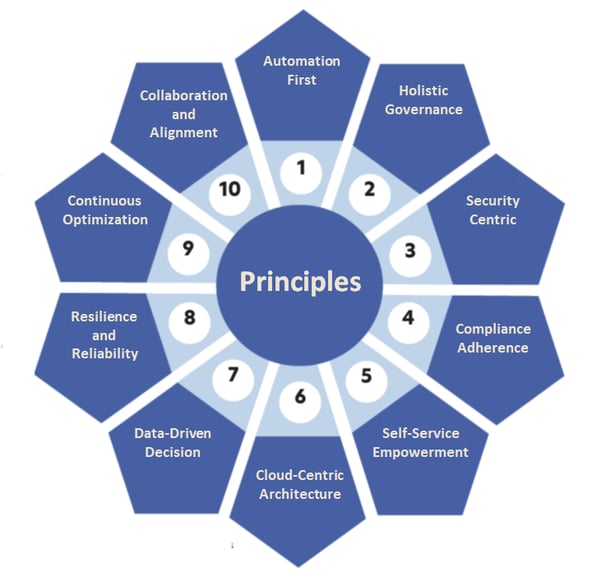Charting a Course to Cloud Excellence: 10 Principles for Seamless Operations
Blog post description.


Introduction: In today's fast-paced digital landscape, cloud operations have become the backbone of modern business success. To navigate this dynamic environment effectively, organizations need a comprehensive framework that not only ensures seamless operations but also drives innovation and resilience. Enter OCCO - the One-Click Cloud Operations framework. With its ten guiding principles, OCCO offers a roadmap for achieving excellence in cloud management. In this blog, we'll dive into each principle and explore how they collectively elevate your cloud operations to new heights.
Automation First: OCCO's first principle underscores the importance of automation in modern cloud operations. By automating routine tasks, organizations can minimize manual errors, improve efficiency, and enable faster response times. Automation streamlines processes, freeing up teams to focus on strategic initiatives and innovation.
Holistic Governance: Effective cloud operations require a holistic approach to governance. OCCO emphasizes integrating governance across security, compliance, finance, and data management. This principle ensures that every facet of cloud operations aligns with organizational goals and industry standards.
Security-Centric Approach: Security is paramount in the cloud era. OCCO's security-centric principle ensures that robust security measures are integrated into every layer of cloud operations. From design and development to deployment and monitoring, a proactive security stance is essential to safeguard against threats.
Compliance Adherence: Navigating complex regulatory landscapes is a challenge every organization faces. OCCO's compliance adherence principle ensures that your cloud operations meet industry regulations and internal policies. This not only mitigates risks but also builds trust with customers and stakeholders.
Self-Service Empowerment: Empowering teams with self-service capabilities is a key driver of agility. OCCO encourages the implementation of self-service platforms, enabling development teams to deploy and manage resources independently. This reduces bottlenecks and accelerates innovation.
Cloud-Centric Architecture: OCCO promotes designing applications and systems with cloud-native principles in mind. By embracing a cloud-centric architecture, organizations can fully leverage the scalability, flexibility, and cost-efficiency that the cloud offers.
Data-Driven Decision Making: In the digital age, data is a strategic asset. OCCO's data-driven principle advocates leveraging data analytics to make informed decisions. By analyzing operational insights, organizations can optimize resource utilization, enhance performance, and drive continuous improvement.
Resilience and Reliability: Cloud downtime can have severe repercussions. OCCO's resilience and reliability principle focuses on building systems that are robust and fault-tolerant. This ensures that even in the face of disruptions, your operations continue uninterrupted.
Continuous Optimization: The cloud landscape is ever-evolving. OCCO's continuous optimization principle encourages organizations to regularly assess and optimize cloud resources, costs, and performance. By doing so, you can ensure that your operations are always efficient and aligned with business goals.
Collaboration and Alignment: Successful cloud operations are a result of effective collaboration between teams. OCCO's collaboration and alignment principle promotes a culture of teamwork, breaking down silos between development, operations, and business units. This alignment ensures that everyone is working towards shared objectives.
Let's dive into how the OCCO principles can be effectively applied to the One-Click Cloud Operation (OCCO) governance, enabling organizations to achieve seamless and efficient cloud management:
1. Automation First:
Automate resource provisioning, deployment, and scaling to enable one-click operations.
Implement automated testing and monitoring to ensure consistent performance and reliability.
Utilize automated incident response and resolution processes for rapid issue handling.
2. Holistic Governance:
Develop comprehensive cloud governance policies that encompass security, compliance, data management, and more.
Establish cross-functional governance boards to ensure alignment and collaboration across different areas.
Regularly review and update governance frameworks to adapt to evolving business needs and industry regulations.
3. Security-Centric Approach:
Embed security measures into every stage of cloud operations, from design to deployment.
Implement automated security monitoring and threat detection to promptly identify and mitigate risks.
Utilize identity and access management (IAM) solutions to enforce role-based access controls and ensure data security.
4. Compliance Adherence:
Implement automated compliance checks to ensure adherence to regulatory standards and internal policies.
Utilize cloud-native compliance tools to monitor and report on compliance status in real-time.
Implement automated audit trails and documentation to facilitate compliance audits.
5. Self-Service Empowerment:
Provide developers with self-service platforms for provisioning and managing cloud resources.
Implement automated workflows for code deployment, enabling developers to release updates with minimal manual intervention.
Foster a culture of innovation by enabling teams to experiment and iterate through self-service capabilities.
6. Cloud-Centric Architecture:
Design applications with cloud-native principles, leveraging microservices, containers, and serverless architectures.
Utilize Infrastructure as Code (IaC) tools to define and manage cloud resources through code.
Implement automated blue-green or canary deployment strategies for seamless updates.
7. Data-Driven Decision Making:
Utilize data analytics and monitoring tools to gather insights into cloud resource utilization, performance, and cost.
Implement automated data backup and disaster recovery processes to safeguard critical data.
Leverage automated data governance tools to ensure data quality, privacy, and compliance.
8. Resilience and Reliability:
Implement automated failover and load balancing mechanisms to ensure high availability.
Utilize automated backup and recovery processes to minimize downtime in case of failures.
Implement automated scaling based on resource utilization patterns to maintain performance.
9. Continuous Optimization:
Utilize automated cost management tools to analyze cloud spending patterns and identify optimization opportunities.
Implement automated resource scaling based on demand to optimize resource allocation.
Utilize machine learning algorithms to predict future resource needs and optimize provisioning.
10. Collaboration and Alignment:
Establish cross-functional teams that include members from different areas of the organization for unified cloud management.
Implement automated communication and collaboration tools to facilitate seamless information sharing.
Utilize automated performance dashboards and reporting to ensure transparency and alignment across teams.
Conclusion: OCCO's ten principles provide a comprehensive and strategic approach to mastering cloud operations. By adhering to these principles, organizations can achieve not only one-click cloud operations but also a future-ready cloud environment that is secure, compliant, and optimized for success. Embrace OCCO and unlock the full potential of your cloud operations in today's digital age.
